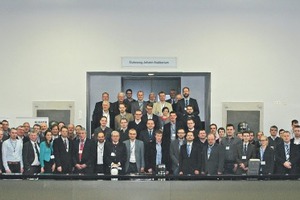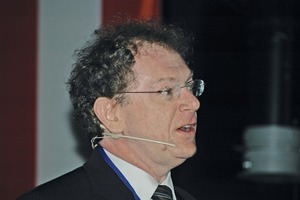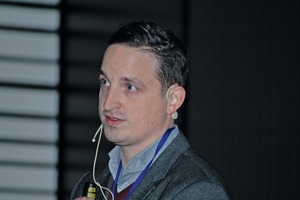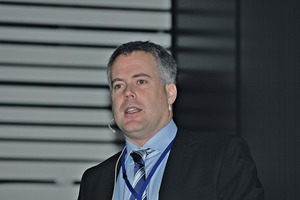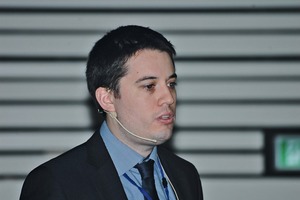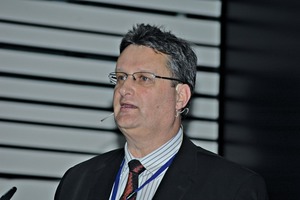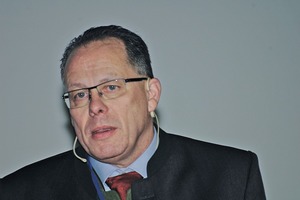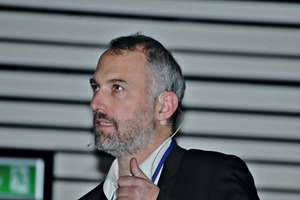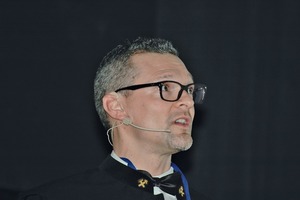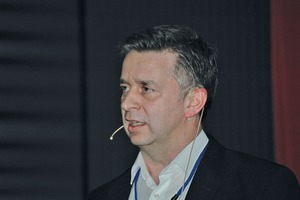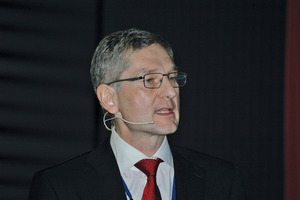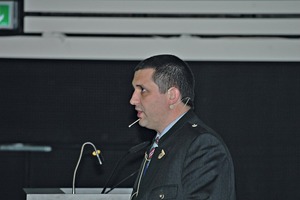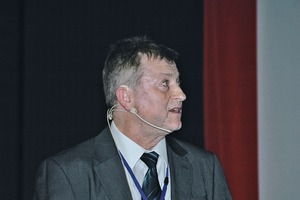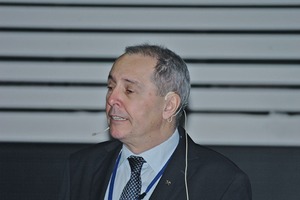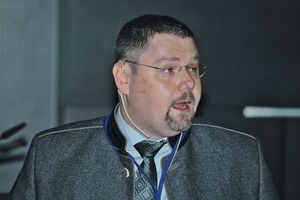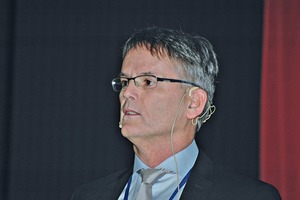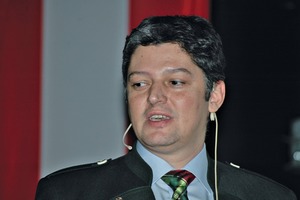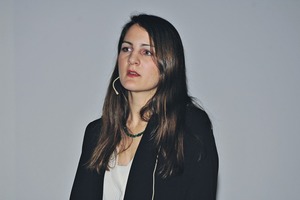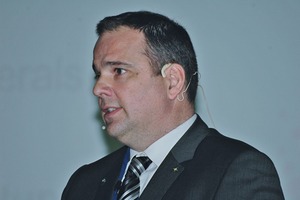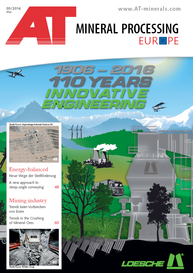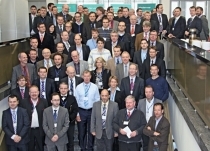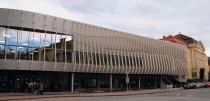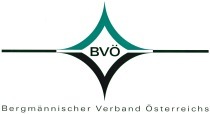Advances in the processing of primary and secondary resources – Mineral Processing Seminar 2016 in Leoben
This year’s seminar was held on 28 and 29 January under the motto “Advances in the processing of primary and secondary resources – machinery, processes, products”. In 18 presentations, plant engineering companies, users and representatives of universities presented new equipment, revamps and extensions as well as current research findings (Fig. 1).
Prof. Markus Lehner from the Chair of Process Technology and Industrial Environmental Protection, Montanuniversitaet Leoben (Fig. 2), presented an ongoing research project on material recycling of plastic waste. From a mix of different plastics, which also contains organic and mineral impurities, the polyolefins are to be recovered as low-gravity materials in density separation. Together with corresponding crude oil interim products, these can be cracked and then reconstituted to new plastics. In contrast to standard plastics recycling, with this process, the quality of the plastics is preserved.
Dipl.-Ing. (FH) Florian Salzer, w&p Zement GmbH (Fig. 3), then spoke on the extension of a WDF unit of a cement plant, as part of which the switch was made to a rocket mill for fine grinding. In this machine, the feed material is ground with rotating chains. With only a slight increase in energy costs, a significant cost saving can be registered overall. The changed properties of the waste-derived fuel have a positive effect on the cement burning process.
To cool products, any residual moisture contained in them can be used. Dipl.-Ing. Robert Primavesi, Almo Engineering GmbH (Fig. 4), compared a conventional drum dryer and one equipped with evaporation cooling. The latter is more expensive to buy on account of its more complex design, but boasts smaller-size components as well as lower power and fuel costs.
In his talk, Dr Paul Meissner, K+S Analytik- und Forschungszentrum (Fig. 5), began by discussing the basic principles and challenges in photooptical particle size analysis. One challenge, for example, is segmentation, that is the segmenting of images areas with overlapping particles into individual particles. Referencing a concrete case study, he showed how effectively such an online system can support the maintenance of a particle size distribution at the discharge of a disk pelletizer.
The applications of sensor-based sorting have widened significantly owing to steady further development in recent years. Dr Helfried Gschaider, Binder+Co AG (Fig. 6), presented three different integrated solutions in which the central sorting is based on transmitted light, reflected light and the near-infrared spectrum.
Ing. Harald Mitterbauer, G&S Metallwerk GmbH (Fig. 7), presented a processing plant for metal-containing waste that went into operation in 2013. Thanks to its modular and redundant design, it can respond flexibly to changes in the composition of the feed with high availability. Its high level of automation means labour costs are very low.
In the near future, the return of Li traction batteries will steadily increase each year. To achieve the prescribed recycling rate at lower costs that with the current pyro- and hydrometallurgical processes, a mechanical processing method was developed in a project lasting several years at the Institute of Mechanical Process Engineering and Mineral Processing at Freiberg University of Mining and Technology, which was presented by Prof. Urs Peuker from the Institute (Fig. 8). Key parts of the process have already been realized on pilot plant scale.
Dr Andreas Pfeiler, Austrian Association of the Brick and Ceramic Industry (Fig. 9), provided an overview of standards and regulations applying to aggregates for road construction. Besides explaining the definition of certain terms, he discussed the requirements for the materials. Some changes in the legal requirements can be foreseen as within the scope of Europe 2020 great importance is attached to waste reduction with increased recycling rates.
The EU Energy Efficiency Directive prescribes that the primary energy requirement is reduced by 20 % by 2020. This has been realized in Austria’s Federal Energy Efficiency Act. Besides its requirements for large companies and energy suppliers, Dipl.-Ing. Dragan Bill, Rohrdorfer Sand und Kies GmbH (Fig. 10), reported on the successful implementation of the requirements in his company with reference to concrete and sometimes very simple measures.
At a porphyritic copper deposit, the changing composition of the feed consisting of three different ore types leads to severe selectivity problems in flotation. Dr Wolfram Bernhart, Metso Austria GmbH (Fig. 11), described the extensive systematic laboratory tests that with an alternative collector and increased pH value in intermediate product grinding led to improved selectivity. It was also shown that the general process flow in the intermediate product grinding is not automatically expedient.
Dr. Alfred Stadtschnitzer, VA Erzberg GmbH (Fig. 12), reported on the use of sensor-assisted sorting at a siderite deposit. Two problems in the mineral processing there result from the entrainment of gangue as well as locally accumulated impurities. For this reason, if required, the particle size range 30-100 mm is processed by means of XRF and optical imaging and the size range 8-30 mm by means of X-ray analysis and optical imaging.
High NOx, CO and TOC values in the flue gas of a cement plant were the reason for the search for an improved flue gas purification system. Dipl.-Ing. Anton Secklehner, KIRCHDORFER Zementwerk Hofmann GesmbH (Fig. 13), explained how the first pilot plant tests (with SCR and Oxi-Kat) failed within 24 h as all different oxidation catalysts lose their effect. In the second pilot phase with the combination of SCR and RTO, the CO reduction could be maintained with the regenerative technology. The large-scale plant built according to the principle had been commissioned a few weeks before the talk.
The RIC ESEE (Regional Innovation Center on Raw Materials for East and South East Europe) based at the Montanuniversitaet Leoben is Austria’s first participation in a Knowledge & Innovation Community (KIC) of the European Institute of Technology (EIT). Dr Alfred Maier, Montanuniversitaet Leoben (Fig. 14), presented this organization with its objectives and activities. One main purpose of the KIC is the support of innovative companies with the transition of new products from research findings to market maturity in the broad field of raw materials, the main objective of the RIC ESEE is to assure the supply of raw materials in Europe.
GROUND UNIT, a processing plant for contaminated soils has been extended as part of a second phase for flotation of the filter cake < 1 mm. Dipl.-Wirt.-Ing. Günter Hirsch, voestalpine Stahl GmbH (Fig. 15), explained the background and tasks of the process. Following laboratory- and large-scale tests, the extension was successfully commissioned. Without further treatment, around 15 % of the feed ends up as filter cake that can hardly be recycled, with flotation it is, however, possible to recover a large part of the contamination in just 3 % of the feed. The flotation underflow is only contaminated to a small extent.
Dipl.-Ing. Erwin Schneller, SBM Mineral Processing GmbH (Fig. 16), and DI Hermann Almer, SBM Mineral Processing GmbH (Fig. 17), presented a jaw crusher with overload protection based on automatic gap adjustment. With the continuous measurement of the crushing force, the ingress of objects that cannot be crushed in the crushing chamber is detected, at which the gap width is increased by a freely selected amount for a short time. After the impurity has been discharged, the selected gap width is reset. This machine is suitable, for example, for crushing slag or railway sleepers with their large fittings.
Dipl.-Ing. Hermann Almer then stood in at short notice for Ing. Bauhofer and described a new crusher for raw gypsum, which completely replaced the equipment from the year 1971. The requirements include the switch from batch to continuous size reduction, a considerable increase in production capacity with the simultaneous switch from continuous three-shift operation to just one shift Mon-Fri and unmanned operation.
Julie Gilles, Metso Minerals (France) S.A. (Fig. 18), began by discussing the differences between agitated cells and flotation columns, the latter being used primarily in the cleaning stages. She then compared conventional aeration systems in column flotation with a proprietary novel system. This should lead to much finer distribution of the bubble sizes and consequently to higher content in the concentrate combined with higher yield.
For over a decade, sorting in an electrostatic field has been a permanent area of research at the Chair of Mineral Processing at the Montanuniversitaet Leoben. Following a review of aspects already addressed, Prof. Helmut Flachberger, Montanuniversitaet Leoben (Fig. 19), presented the two current dissertations on the topic: one on basic questions regard a deeper understanding of tribocharging, the second on application-oriented tests in which electrostatic separation is used in processing graphites to support or completely replace flotation.
The next Mineral Processing Seminar will be held on 16 and 17 January 2017 with the same keynote. The talks will probably result in the proven mix of theory and practice.

